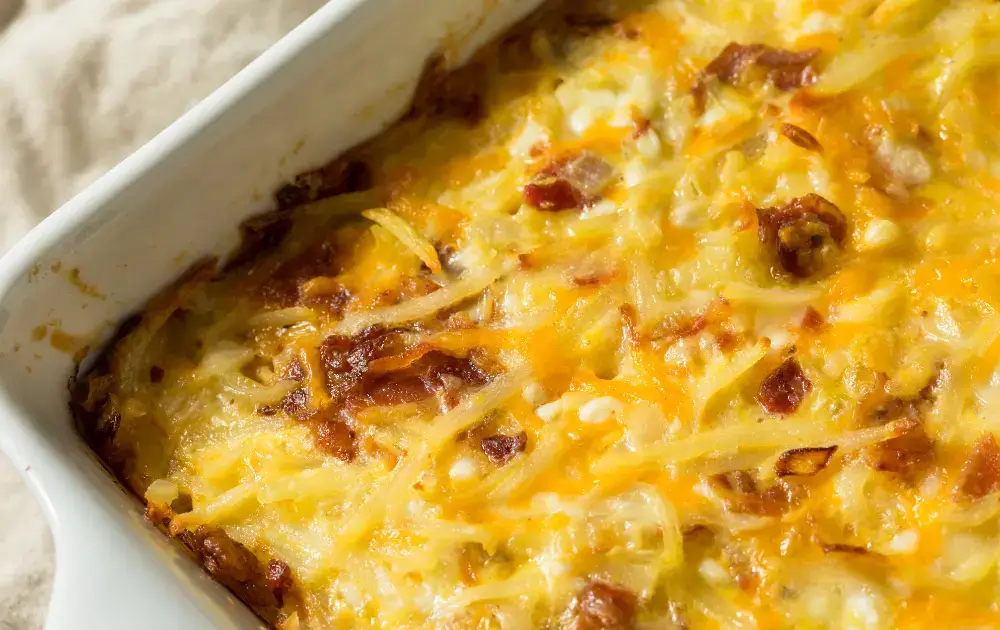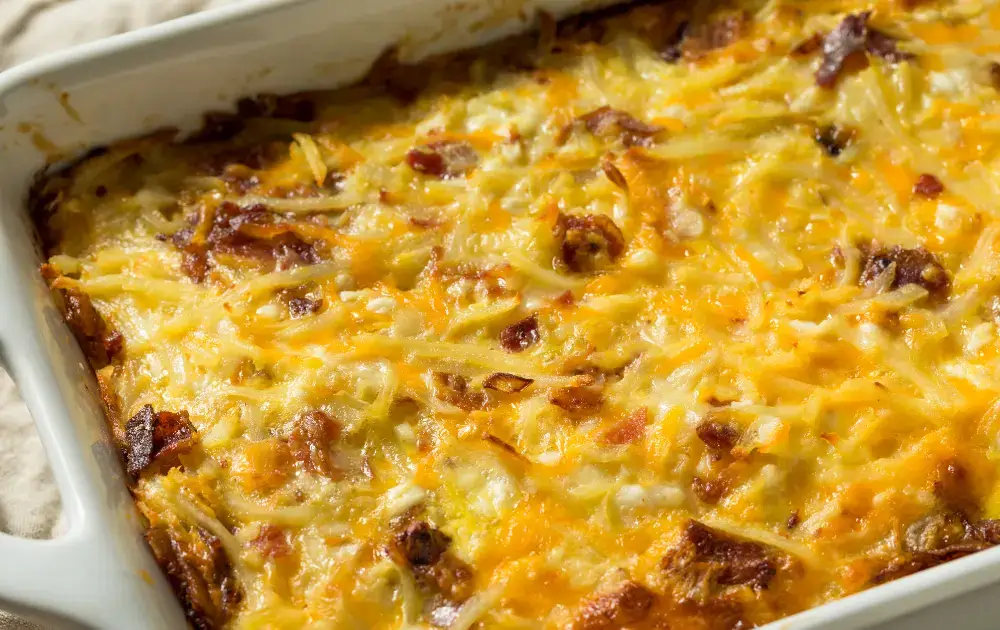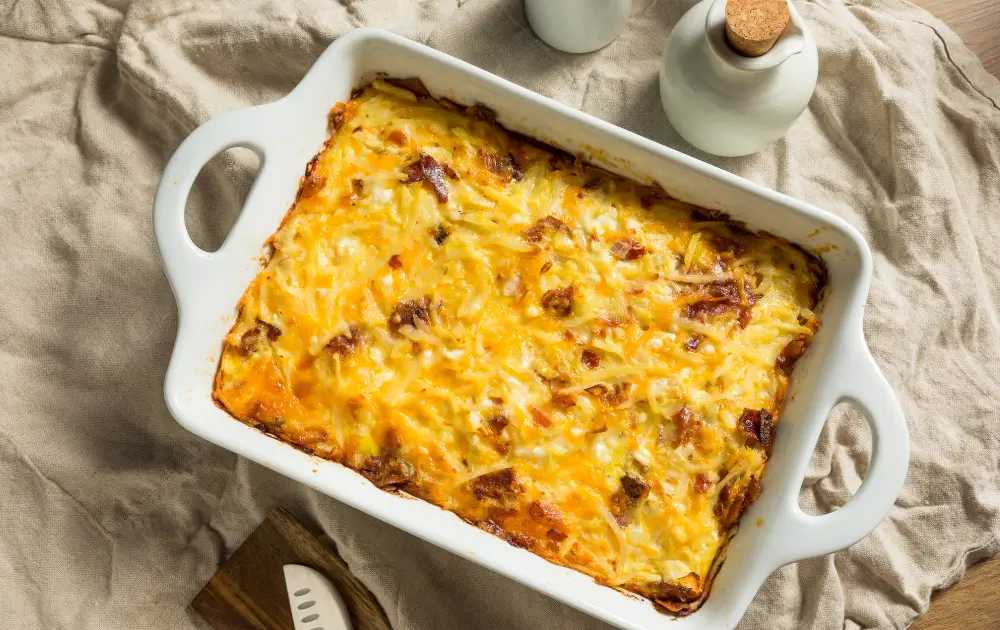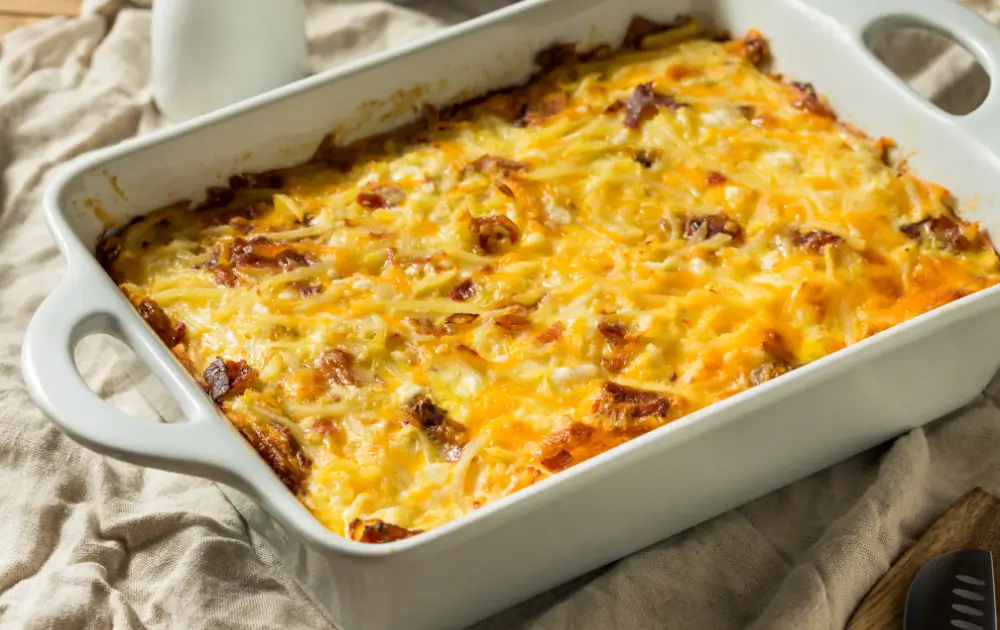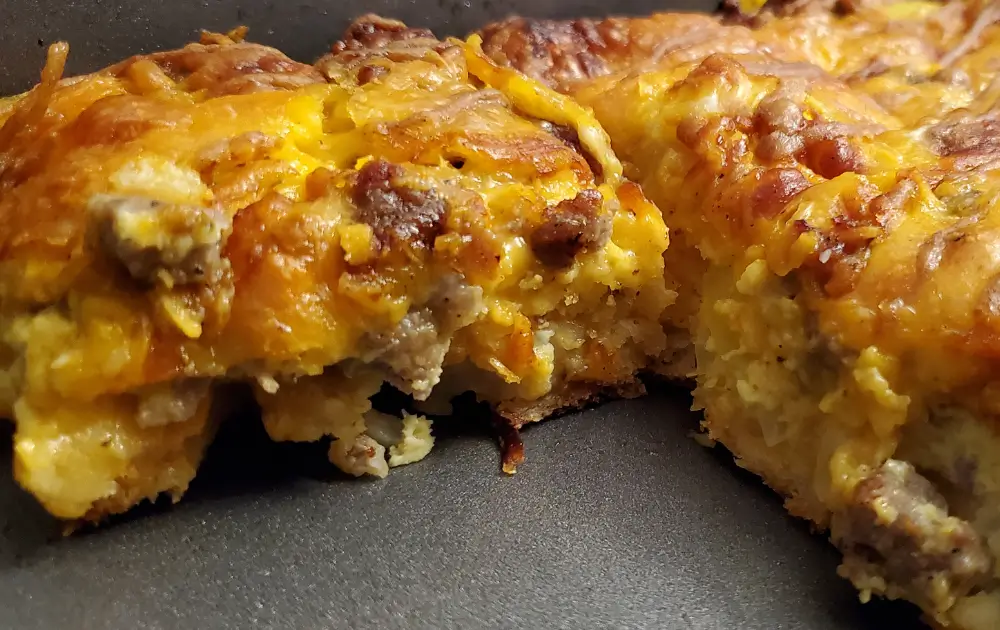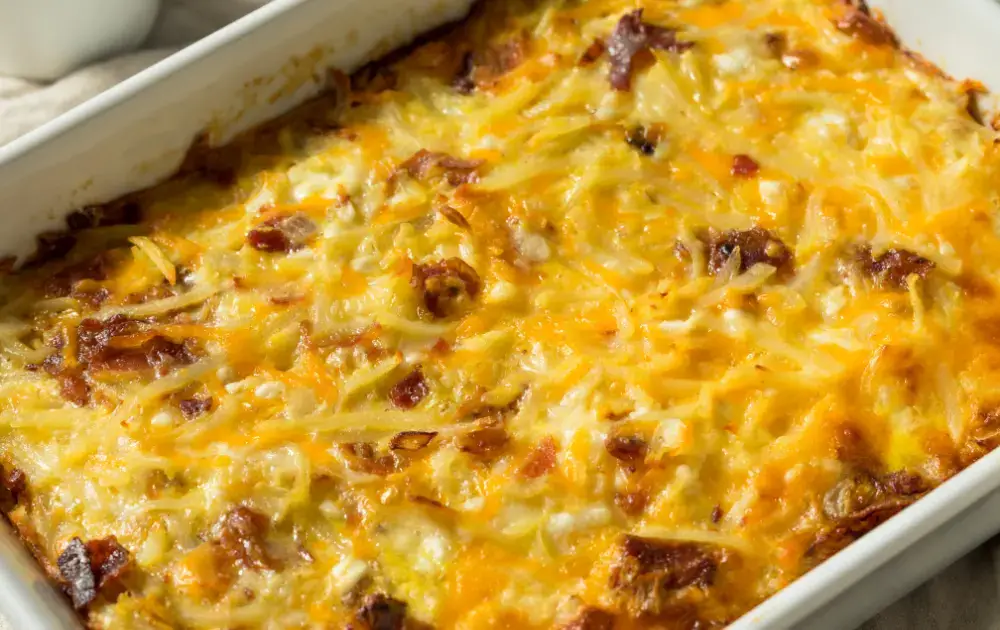Ultimate Guide to Breakfast Casserole: Delicious Morning Delights
Introduction
Breakfast casseroles are a staple in many households, known for their convenience and versatility. These hearty dishes, perfect for feeding a crowd, combine various ingredients like eggs, cheese, meats, and vegetables, baked to perfection. They are ideal for lazy weekends, special occasions, or meal-prepping for busy mornings.
Part 1: The History and Evolution of Breakfast Casseroles
Breakfast casseroles have evolved from simple egg-based dishes to elaborate meals. Originating from European traditions, they have become a beloved part of American breakfast culture. Over time, these casseroles have adapted to include a range of ingredients, reflecting local tastes and preferences.
Part 2: Types of Breakfast Casseroles
There are numerous types of breakfast casseroles, from meat-based versions loaded with bacon or sausage to vegetarian options featuring an array of vegetables. Sweet casseroles, like French toast bakes, add a dessert-like twist to the breakfast table. Each region has its unique take, incorporating local flavors and ingredients.
Part 3: Essential Ingredients for a Perfect Breakfast Casserole
The key to a great breakfast casserole lies in its ingredients. Eggs and cheese provide a rich base, while bread or potatoes add substance. Meats like ham or bacon offer savoriness, and vegetables bring freshness and color. Experimenting with different combinations can yield delightful results.
Part 4: Step-by-Step Guide to Making a Classic Breakfast Casserole
A classic breakfast casserole might include layers of bread, cooked sausage, cheese, and a mixture of eggs and milk. The preparation involves layering these ingredients in a baking dish and baking until the eggs are set and the top is golden brown. Seasonings like salt, pepper, and herbs enhance the flavor.
Breakfast Casserole Recipe
Ingredients:
- 6 large eggs
- 2 cups whole milk
- 1 teaspoon mustard powder
- Salt and pepper, to taste
- 6 cups cubed bread (day-old bread works best)
- 1 cup shredded cheddar cheese
- 1 cup cooked and crumbled sausage (or bacon/ham)
- 1 small onion, finely chopped
- 1 bell pepper, diced (optional)
- 1/2 cup sliced mushrooms (optional)
- 1/2 teaspoon paprika (for garnish)
Instructions:
- Preparation:
- Preheat your oven to 350°F (175°C).
- Grease a 9×13 inch baking dish.
- Mix Eggs and Milk:
- In a large bowl, whisk together the eggs, milk, mustard powder, salt, and pepper.
- Assemble the Casserole:
- Place the cubed bread evenly in the bottom of the greased baking dish.
- Sprinkle the shredded cheese over the bread.
- Add the cooked sausage, onion, bell pepper, and mushrooms evenly over the cheese.
- Pour the egg and milk mixture over the entire casserole, ensuring all ingredients are covered.
- Let it Soak:
- Gently press down with a spatula to make sure everything is soaked evenly.
- For best results, let the casserole sit for about 15 minutes to absorb the egg mixture, or cover and refrigerate overnight.
- Bake the Casserole:
- Bake in the preheated oven for 45-50 minutes, or until the top is golden brown and the center is set.
- Sprinkle paprika over the top for a bit of color and flavor.
- Serve:
- Let the casserole cool for a few minutes before serving.
- Cut into squares and serve warm.
Tips:
- Bread Choice: You can use any type of bread, but slightly stale bread absorbs the egg mixture better.
- Customization: Feel free to add other vegetables like spinach or tomatoes, or swap out the meats and cheeses based on your preference.
- Make-Ahead: This casserole can be prepared the night before and baked in the morning for an easy breakfast.
Enjoy your delicious Breakfast Casserole, perfect for a family breakfast or a festive brunch!
Part 5: Advanced Cooking Techniques
Achieving the perfect texture in a breakfast casserole involves balancing the moisture from the eggs and milk with the absorbency of the bread or potatoes. Baking at the right temperature ensures a crispy top and a fully cooked interior. Creative twists, like adding a crunchy topping or a swirl of pesto, can elevate the dish.
Part 6: Dietary Considerations and Substitutions
For dietary restrictions, breakfast casseroles can be easily adapted. Gluten-free bread or potatoes can replace regular bread for a gluten-free version. Dairy-free milk and cheese substitutes cater to lactose intolerance, and plant-based meats and egg substitutes make the dish vegan-friendly.
Part 7: Serving and Presentation
Serving a breakfast casserole can be as simple or as elegant as desired. Garnishing with fresh herbs or avocado slices adds a touch of sophistication. Pairing the casserole with sides like fruit salad or a refreshing beverage completes the meal.
Part 8: FAQs Section
Common questions about breakfast casseroles include inquiries about make-ahead options, storage, and reheating. Tips for perfect results include not overfilling the baking dish and allowing the casserole to rest before serving.
Breakfast casseroles are a testament to the joy of shared meals and the creativity of home cooking. Their versatility and ease make them a favorite for any occasion. Whether you stick to classic recipes or experiment with new flavors, breakfast casseroles are sure to delight.
Part 9: Nutritional Aspects of Breakfast Casseroles
Balancing Nutrition in Casseroles
While breakfast casseroles are often indulgent, they can be balanced nutritionally. Incorporating ingredients like spinach, tomatoes, or bell peppers adds vitamins and fiber. Using lean meats or plant-based proteins can reduce fat content without sacrificing flavor.
Calorie Consideration and Portion Control
For those mindful of calorie intake, portion control is key. Serving smaller portions alongside a fresh salad or fruit can create a well-rounded meal. Opting for low-fat dairy products and whole grain bread can also help manage calorie count.
Part 10: The Social Aspect of Breakfast Casseroles
Breakfast Casseroles in Gatherings
Breakfast casseroles are perfect for social gatherings like brunches or potlucks. They’re easy to serve and can feed a large number of people, making them ideal for communal dining and holiday celebrations.
Creating Memories with Food
Preparing and sharing a breakfast casserole can create lasting memories, especially during family gatherings or special occasions. It’s a dish that brings people together, offering comfort and warmth.
Part 11: The Convenience of Make-Ahead Casseroles
Preparing Casseroles in Advance
One of the biggest advantages of breakfast casseroles is the ability to prepare them ahead of time. Assembling the casserole the night before and baking it in the morning saves time and reduces stress, especially when hosting guests.
Freezing and Reheating Tips
Breakfast casseroles can often be frozen and reheated, making them a convenient option for meal prep. Proper storage and reheating techniques ensure the casserole retains its texture and flavor.
If you’re looking to complement your breakfast casserole with a savory side, the Garlic Mashed Potatoes recipe from RecipStep offers a delicious and comforting option that pairs wonderfully with the rich flavors of the casserole.
Part 12: Pairing Breakfast Casseroles with Beverages
Beverage Combinations
Pairing the right beverage with a breakfast casserole can enhance the dining experience. Coffee, tea, or fresh juices are classic choices. For a special brunch, mimosas or Bloody Marys can add a festive touch.
Non-Alcoholic Options
For non-alcoholic options, smoothies, flavored waters, or herbal teas can be refreshing and complement the richness of the casserole.
Embracing the Versatility of Breakfast Casseroles
Breakfast casseroles are a testament to culinary versatility and creativity. They offer endless possibilities for customization, fitting into any dietary preference or occasion.
An Invitation to Culinary Exploration
As you explore the world of breakfast casseroles, let them inspire you to experiment with flavors, ingredients, and presentations. Whether for a quiet family breakfast or a grand brunch gathering, breakfast casseroles are sure to delight and satisfy.
Part 13: Seasonal and Holiday Variations of Breakfast Casseroles
Adapting Casseroles for Seasons
Breakfast casseroles can be adapted to fit the flavors of each season. In autumn, ingredients like pumpkin or sweet potatoes add a festive touch. For summer, lighter versions with fresh vegetables and herbs are perfect.
Holiday-Themed Casseroles
During holidays, breakfast casseroles can become a centerpiece. For Christmas, adding ingredients like cranberries or nutmeg can create a festive feel. Easter versions might include spring vegetables and lighter cheeses.
Part 14: The Art of Layering in Casseroles
Mastering Layering Techniques
The key to a great breakfast casserole lies in how ingredients are layered. Starting with a base of bread or potatoes, followed by meats or vegetables, and topped with a mixture of eggs and cheese ensures even cooking and flavor distribution.
Creative Layering Ideas
Experimenting with different layering techniques can result in unique textures and flavors. Alternating layers of different ingredients or creating a lattice pattern with vegetables can make the casserole visually appealing and delicious.
Part 15: Incorporating Global Flavors into Breakfast Casseroles
Exploring International Ingredients
Breakfast casseroles can be infused with flavors from around the world. Adding ingredients like chorizo for a Spanish twist or using spices like turmeric or cumin can give the dish an exotic flavor profile.
Fusion Breakfast Casseroles
Creating fusion breakfast casseroles by combining elements from different cuisines can result in exciting new dishes. For example, an Italian-inspired casserole with sun-dried tomatoes and basil or an Asian-inspired version with soy sauce and scallions.
Part 16: Breakfast Casseroles for Special Diets
Gluten-Free and Dairy-Free Options
For those with dietary restrictions, breakfast casseroles can be modified to be gluten-free by using gluten-free bread or potatoes. Dairy-free versions can utilize plant-based milk and cheese substitutes.
Low-Carb and Keto-Friendly Casseroles
Creating low-carb or keto-friendly breakfast casseroles involves focusing on high-protein and low-carb ingredients like eggs, cheese, and meats, while avoiding bread or high-carb vegetables.
Celebrating the Diversity of Breakfast Casseroles
Breakfast casseroles are a celebration of diversity and creativity in the kitchen. They offer a canvas for culinary experimentation, allowing cooks to blend tradition with innovation.
An Invitation to Delight in Breakfast Casseroles
As you delve into the world of breakfast casseroles, embrace the opportunity to create dishes that bring joy and satisfaction. Whether serving a classic recipe or a creative new version, breakfast casseroles are sure to be a delightful start to any day.
Part 17: The Role of Breakfast Casseroles in Healthy Eating
Nutritional Benefits of Casseroles
Breakfast casseroles can be a part of a healthy diet when prepared with the right ingredients. Incorporating a variety of vegetables, lean proteins, and whole grains can make them a nutritious option that provides essential nutrients.
Balancing Indulgence with Health
While some breakfast casseroles are indulgent, they can be balanced with healthier ingredients. Using low-fat dairy products, adding fiber-rich vegetables, and reducing the amount of processed meats can make them a healthier choice without sacrificing taste.
Part 18: The Convenience Factor of Breakfast Casseroles
Meal Prep and Time-Saving Aspects
One of the biggest advantages of breakfast casseroles is their convenience. They can be prepared in advance, making them perfect for meal prep or busy mornings. This time-saving aspect is particularly beneficial for families or individuals with hectic schedules.
Freezer-Friendly Breakfast Options
Many breakfast casseroles are freezer-friendly, allowing for easy storage and quick reheating. This makes them an ideal option for those who like to cook in bulk and have ready-to-eat meals on hand.
Part 19: Creative Presentation and Garnishing Tips
Elevating the Presentation
The presentation of a breakfast casserole can enhance the dining experience. Garnishing with fresh herbs, colorful vegetables, or a sprinkle of cheese can make the dish visually appealing and more appetizing.
Serving Ideas for Special Occasions
For special occasions, breakfast casseroles can be presented in unique ways. Serving individual portions in ramekins or creating a themed presentation can add a special touch to celebrations and gatherings.
Part 20: Engaging with the Community Through Casseroles
Sharing Recipes and Experiences
Sharing breakfast casserole recipes and experiences with others, whether through social media, cooking blogs, or community events, can be a way to connect with fellow food enthusiasts and exchange ideas.
Breakfast Casseroles in Community Events
Breakfast casseroles are great for community events like potlucks, brunch gatherings, or charity breakfasts. They are easy to transport, serve, and are generally well-received by a wide range of people.
Part 21: Seasonal Ingredients and Their Impact on Flavor
Embracing Seasonality in Casseroles
Incorporating seasonal ingredients into breakfast casseroles not only enhances flavor but also ensures freshness. Spring vegetables, summer fruits, autumnal squash, and hearty winter ingredients can transform the taste and texture of the casserole, reflecting the essence of each season.
The Flavorful Benefits of Seasonal Produce
Using seasonal produce in casseroles brings out robust and vibrant flavors. For instance, adding fresh asparagus in spring or pumpkin in fall can elevate the dish, making it a reflection of the season’s bounty.
Part 22: The Art of Baking the Perfect Casserole
Baking Techniques for Optimal Results
Achieving the perfect bake is crucial for a breakfast casserole. This involves understanding oven temperatures, baking times, and the importance of letting the casserole rest before serving to ensure that it sets properly and flavors meld together.
Tips for a Golden and Crispy Top
A golden, crispy top is often desired in a breakfast casserole. This can be achieved by adjusting the oven’s broil setting in the final minutes of baking or by adding a layer of cheese or breadcrumbs on top for added texture.
For a delightful and festive beverage to accompany your breakfast casserole, consider trying the Grinch Punch, perfect for adding a splash of color and fun to your breakfast table.
Part 23: Pairing Casseroles with Other Breakfast Items
Complementary Breakfast Dishes
While breakfast casseroles are a complete meal in themselves, pairing them with other items can create a well-rounded breakfast spread. Suggestions include fresh fruit, yogurt parfaits, pastries, or a selection of breakfast meats.
Beverage Pairings for a Complete Meal
Choosing the right beverages to accompany breakfast casseroles can enhance the overall dining experience. Coffee, tea, fresh juices, or even a breakfast cocktail can complement the flavors of the casserole and complete the meal.
Part 24: The Role of Breakfast Casseroles in Diet and Nutrition
Nutritional Considerations
Understanding the nutritional aspects of breakfast casseroles is important. While they can be rich in protein and other nutrients, being mindful of ingredients like cheese and processed meats is key to maintaining a balanced diet.
Adapting Casseroles for Healthier Eating
For a healthier approach, incorporating whole grains, lean proteins, and an abundance of vegetables can make breakfast casseroles a nutritious option. Reducing high-fat ingredients and using substitutes like egg whites or low-fat dairy products can also contribute to a healthier dish.
Conclusion
The Endless Possibilities of Breakfast Casseroles
Breakfast casseroles are a testament to culinary creativity and versatility. They offer endless possibilities for customization, fitting into any meal plan, occasion, or dietary preference, making them a cherished dish in kitchens worldwide.
A Celebration of Shared Meals and Memories
Breakfast casseroles are more than just a dish; they are a celebration of shared meals and memories. They bring people together, offering comfort, nourishment, and joy. As you continue to explore and experiment with breakfast casseroles, embrace the opportunity to create your own traditions and enjoy the simple pleasures of a shared table.
Print
Breakfast Casserole
- Total Time: 1 hour 10 minutes
- Yield: 8 servings 1x
- Diet: Vegetarian
Description
A hearty and delicious breakfast casserole that combines eggs, cheese, breakfast meats, and bread in one dish. It’s perfect for feeding a crowd, meal prep, or special weekend brunches. This versatile casserole can be customized with various ingredients and is sure to be a hit with both kids and adults.
Ingredients
- 1 lb (450g) breakfast sausage, cooked and crumbled
- 6 slices of bread, cubed
- 1 cup cheddar cheese, shredded
- 8 large eggs
- 2 cups milk
- 1 teaspoon mustard powder
- Salt and pepper to taste
- Optional: diced vegetables such as bell peppers, onions, or mushrooms
Instructions
- Preheat your oven to 350°F (175°C). Grease a 9×13 inch baking dish.
- Layer the bottom of the dish with cubed bread. Sprinkle the cooked sausage and optional vegetables evenly over the bread. Top with shredded cheese.
- In a large bowl, whisk together eggs, milk, mustard powder, salt, and pepper. Pour this mixture over the bread, sausage, and cheese layers in the baking dish.
- Bake in the preheated oven for 45-55 minutes, or until the eggs are set and the top is golden brown.
- Let the casserole cool for a few minutes before serving.
Notes
- For best results, let the bread cube layer sit overnight soaked in the egg mixture. This helps the bread absorb the flavors and makes the casserole more cohesive.
- Feel free to substitute the sausage with bacon, ham, or a vegetarian alternative.
- The casserole can be made ahead and refrigerated overnight before baking.
- Prep Time: 15 minutes
- Cook Time: 55 minutes
- Category: Breakfast
- Method: Baking
- Cuisine: American
Nutrition
- Calories: 350
- Sodium: 700mg
- Fat: 22g
- Saturated Fat: 9g
- Carbohydrates: 15g
- Fiber: 1g
- Protein: 22g


